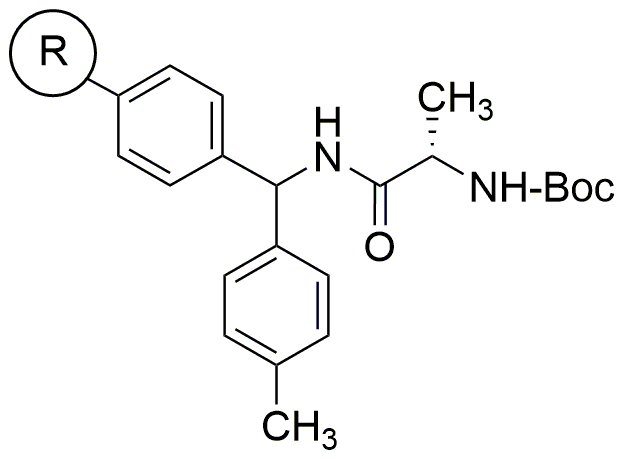Boc-L-alanine 4-methylbenzhydrylamine is widely utilized in research focused on:
- Peptide Synthesis: This compound serves as a key building block in the synthesis of peptides, which are essential for drug development and biological research.
- Drug Development: Its unique structure allows for the creation of novel pharmaceutical compounds, particularly in the development of targeted therapies.
- Bioconjugation: It is used to modify biomolecules, enhancing their stability and efficacy, which is crucial in the field of biochemistry and molecular biology.
- Research in Neuroscience: The compound can be employed in studies related to neurotransmitter functions, aiding in the understanding of various neurological disorders.
- Analytical Chemistry: It is often utilized in chromatography techniques for the separation and analysis of complex mixtures, providing precise identification of compounds.
Informations générales
Propriétés
Sécurité et réglementation
Applications
Boc-L-alanine 4-methylbenzhydrylamine is widely utilized in research focused on:
- Peptide Synthesis: This compound serves as a key building block in the synthesis of peptides, which are essential for drug development and biological research.
- Drug Development: Its unique structure allows for the creation of novel pharmaceutical compounds, particularly in the development of targeted therapies.
- Bioconjugation: It is used to modify biomolecules, enhancing their stability and efficacy, which is crucial in the field of biochemistry and molecular biology.
- Research in Neuroscience: The compound can be employed in studies related to neurotransmitter functions, aiding in the understanding of various neurological disorders.
- Analytical Chemistry: It is often utilized in chromatography techniques for the separation and analysis of complex mixtures, providing precise identification of compounds.
Documents
Fiches de données de sécurité (FDS)
La FDS fournit des informations de sécurité complètes sur la manipulation, le stockage et l’élimination du produit.
Spécifications du produit (PS)
Le PS fournit une description complète des propriétés du produit, notamment sa composition chimique, son état physique, sa pureté et les exigences de stockage. Il détaille également les plages de qualité acceptables et les applications prévues du produit.
Certificats d'analyse (COA)
Recherchez des certificats d'analyse (COA) en saisissant le numéro de lot du produit. Les numéros de lot et de lot se trouvent sur l'étiquette d'un produit, après les mots « Lot » ou « Lot de fabrication ».
Numéro de catalogue
Numéro de lot/série
Certificats d'origine (COO)
Ce certificat d'exploitation confirme le pays dans lequel le produit a été fabriqué, et détaille également les matériaux et composants utilisés et s'il est issu de sources naturelles, synthétiques ou autres sources spécifiques. Ce certificat peut être requis pour les douanes, le commerce et la conformité réglementaire.
Numéro de catalogue
Numéro de lot/série
Fiches de données de sécurité (FDS)
La FDS fournit des informations de sécurité complètes sur la manipulation, le stockage et l’élimination du produit.
DownloadSpécifications du produit (PS)
Le PS fournit une description complète des propriétés du produit, notamment sa composition chimique, son état physique, sa pureté et les exigences de stockage. Il détaille également les plages de qualité acceptables et les applications prévues du produit.
DownloadCertificats d'analyse (COA)
Recherchez des certificats d'analyse (COA) en saisissant le numéro de lot du produit. Les numéros de lot et de lot se trouvent sur l'étiquette d'un produit, après les mots « Lot » ou « Lot de fabrication ».
Numéro de catalogue
Numéro de lot/série
Certificats d'origine (COO)
Ce certificat d'exploitation confirme le pays dans lequel le produit a été fabriqué, et détaille également les matériaux et composants utilisés et s'il est issu de sources naturelles, synthétiques ou autres sources spécifiques. Ce certificat peut être requis pour les douanes, le commerce et la conformité réglementaire.


